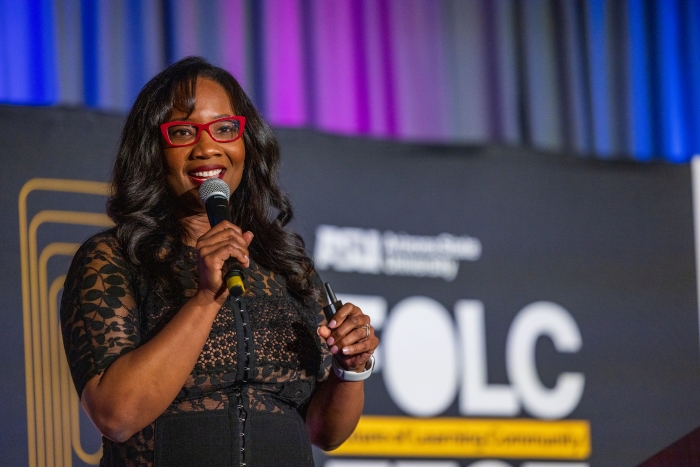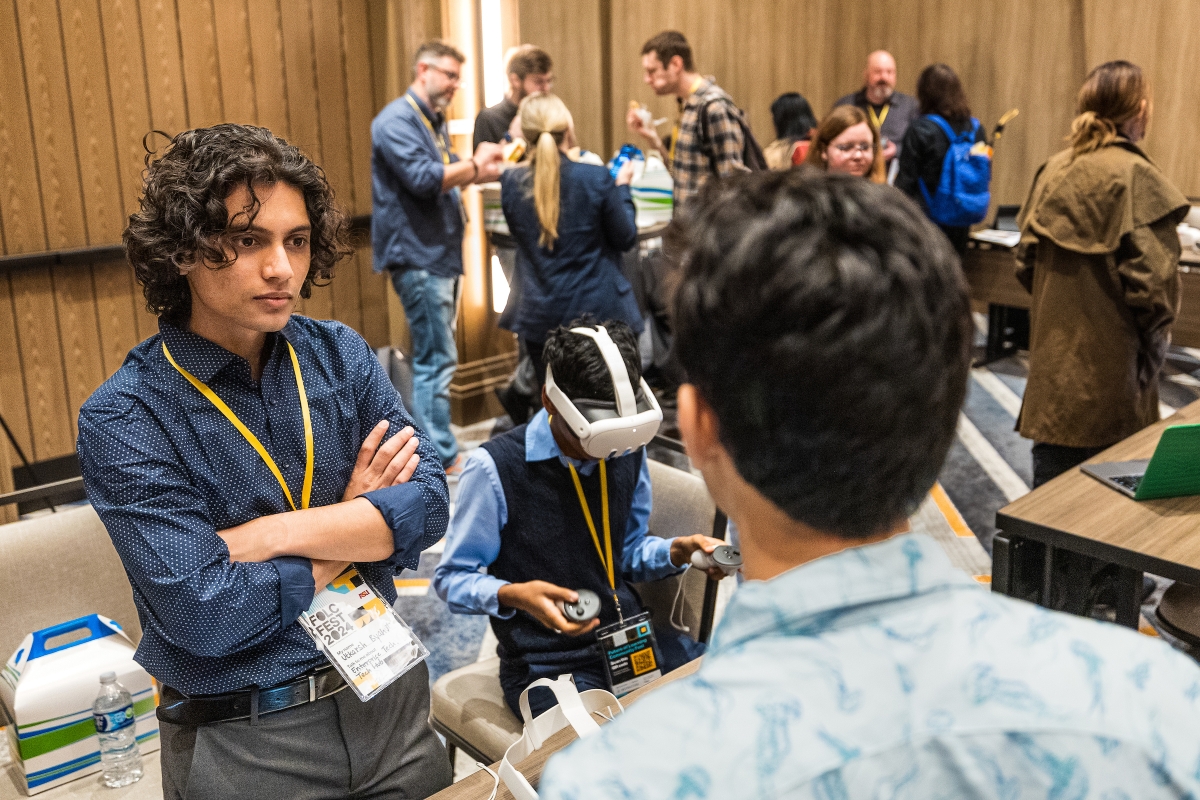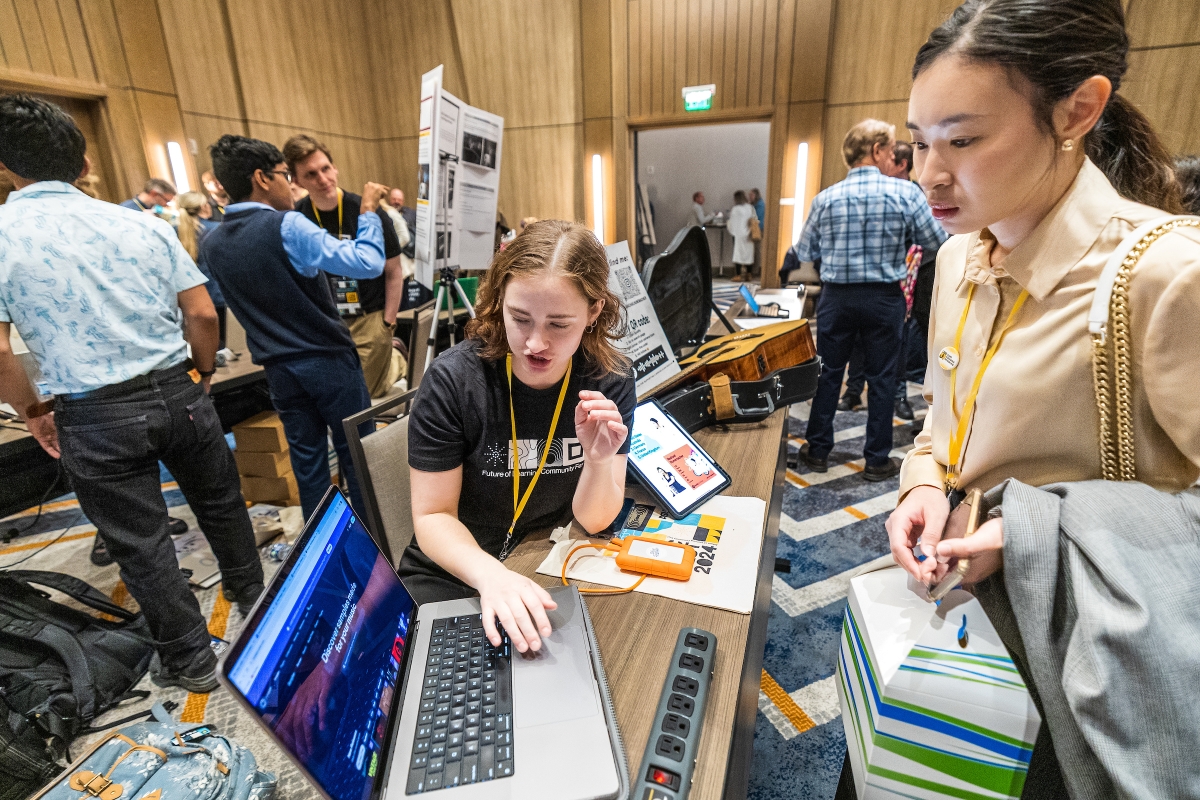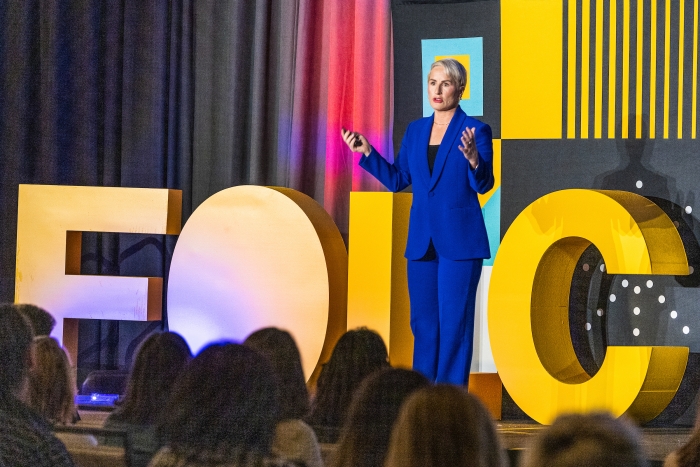First Future of Learning Community Fest celebrates innovation at ASU
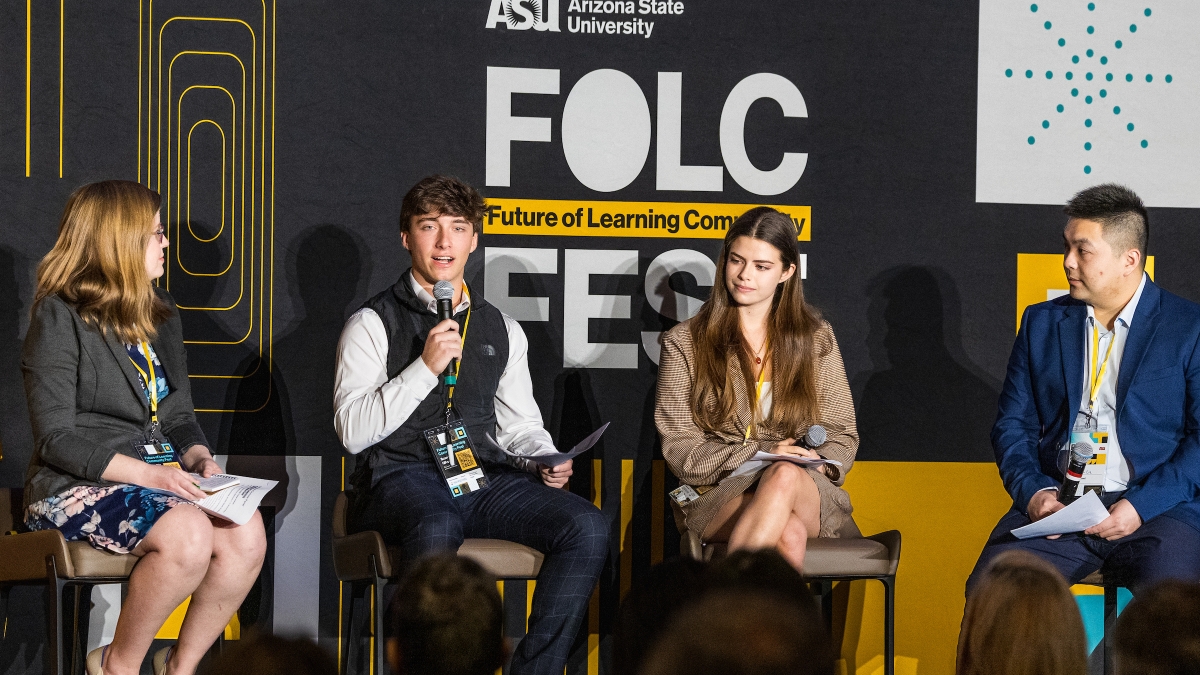
A panel at the Future of Learning Community Fest on March 15 included (from left) graduate student Nicole Oster, undergraduate students Caleb Lieberman and Sophia Herman, and graduate student Frank Liu at the Omni Hotel at ASU. Photo by Charlie Leight/ASU News
The inaugural Future of Learning Community Fest was a celebration of Arizona State University’s innovation in ensuring student success.
The FOLC Fest conference, held March 14–15 at the Omni Hotel at ASU in Tempe, was organized by the Office of the University Provost for the ASU community. The two days were filled with presentations, panel discussions and demonstrations of the ways that ASU has worked to change the model of higher education.
More than 1,000 people in the ASU community — faculty, staff and students — attended, which showed how the university is at the forefront of the future of learning, according to Nancy Gonzales, executive vice president and university provost.
“I have the amazing privilege to lead an academic community that consistently rises to meet the challenges facing our society and our globe, and will be the university that leads the way to serving students of the future,” she said in opening remarks on Thursday.
“We are not just keeping pace with change. We are driving change.”
She urged conference-goers to network.
“Seek opportunities to build and fortify our community. Consider that the person next to you might hold the key to a new perspective, provide you with valuable feedback or offer expert insights into technology,” she said.
Among the topics discussed at the conference were:
Using data to increase inclusivity
Talithia Williams, associate professor of mathematics at Harvey Mudd College, said that faculty sometimes resist using data to drive decisions because they’re actually resisting change.
Williams, co-host of the PBS NOVA series “NOVA Wonders” spoke at a keynote session on Thursday titled, “Enhancing Student Success Through Data-Informed Decision-Making.”
At Harvey Mudd, the computer science department analyzed student data to find out why so few women were becoming majors.
“Here’s what they did besides hiring young, fun faculty,” she said. “They reframed problems as creative problem solving, not just, ‘Let me see if you can program code.’ “
They also set up four separate sections of the introductory class to accommodate the range of students from those who knew nothing about computer science to those who had been learning it since childhood. Students self-selected into the sections, which met at the same time and covered the same material, so students could move among the sections.
They found that 80% of the women selected the “introductory” section and 80% of the men chose the section considered to be more advanced. But the end result was that women computer science majors went from 7% of the total in 2007 to 51% in 2016.
Williams made changes in her own statistics classroom after the murder of George Floyd in 2020.
“I wanted to do something where students could see the impact of statistical thinking and how it might change the outlook of society,” she said.
So her students analyzed data from the New York City police department on its policy of “stop, question and frisk,” in which officers can stop anyone on the street. The students found that while Black people are 23% of the population in the city, they made up 53% of the people who were stopped.
“I wasn’t trained to have these conversations but I did it because I wanted to engage my students in that,” she said.
The role of artificial intelligence
In a panel titled “The Future of Learning at ASU,” top administrators discussed ASU’s new partnership with OpenAI and how it’s driven by the new design aspiration of "Principled Innovation," which is the goal of creating change guided by ethical values.
“We’re one of the only universities I know of that started our entire journey around what it means to augment our intelligence. That starts with Principled Innovation and tries to operationalize it by making sure we first assemble the right kind of human talent, a group of ethicists from across the university, then find the technical rubrics to make sure the frameworks don’t have in them inherent biases,” said Lev Gonick, chief information officer of ASU.
“Principled Innovation is the framework of our journey, and it distinguishes us and differentiates us.”
Gonick said that his Enterprise Technology team is working on creating several large language models for staff, faculty and students, including ASUGPT.
“Our curated set of large language models will give us higher efficiency, better predictability and be curated by faculty and librarians. We’ll train those models to provide all of the power without all of the risk that most of the rest of the higher ed world is dealing with.”
Anne Jones, vice provost for undergraduate education, said that several courses have been developed to teach faculty and students how to use AI.
“I’m excited because I see in AI a change in how we interact with knowledge that democratizes knowledge and that creates a more inclusive community of scholars. And that liberates us to not do routine, mundane kinds of things that can be better done by machines.
“In my own field, I can’t sort through big data and look for patterns like a machine can. I’m not scared I’ll be out of a job. It leaves me to make value judgements and practice Principled Innovation.”
At a panel titled “Student Perspective on the Future of Education,” students gave their views on artificial intelligence:
Nicole Oster, a graduate student pursuing a PhD in learning, literacies and technologies, said she uses AI two ways.
“I use it to digest challenging theoretical text. It helps me break down the text into key components and engage with what feels like a tutor in a back-and-forth exchange. It’s also helpful with word choice and the flow of sentences and getting feedback on writing,” she said.
"At the same time, I’ve been alarmed by the bias, which, to be clear, is our own bias mirrored back to us.”
Sophia Herman, a third-year student majoring in English and civic and economic thought and leadership, said that through the Welcome to America project, she helps refugees move into housing and find jobs, and is shocked at the complexity and red tape that’s encountered.
“I wish there was a way to take this complicated thing people have to deal with to get an apartment and raise a family, and help them navigate the process. It’s cases like that that I see AI helping people that I’m most optimistic about.”
She also said that people need to rethink their approach. “When discussing AI, we say things that separate us from the process, like, ‘The algorithm is doing crazy things.’ We have agency in the process and we can do that in ethical ways. We have a voice.”
Revamping a course to engage students
At a panel titled “Enhancing Student Success,” Joy Griffin, an assistant teaching professor in the Polytechnic School, discussed how she revamped a technology management course after taking it over. She polled students who had taken the course and found that 20% did not find it effective. So she flipped the classroom.
“We looked at the course structure and subbed textbook learning with active learning engagement, gamifying, simulation, case studies. We got rid of the textbook for an open media library. We worked hard to curate over 100 materials — videos, podcasts, articles — that are current and relevant,” she said.
“We did reflection-based assignments. I got the lectures down to 20 minutes.”
Nicholas Lindquist, a multimedia developer in the Learning and Teaching Hub at the Ira A. Fulton Schools of Engineering, helped Griffin create a "Meet the Faculty" video for students.
“‘Meet-the-faculty’ videos build a rapport, humanize faculty and make them more approachable. They’re two to three minutes on YouTube.
“Joy came in and we asked question about her hobbies, her education journey, how did you fall in love with your discipline,” he said.
“The point is, before students even meet the faculty member, the person is real, and it establishes them as the authority figure and subject matter expert.”
Lindquist also helped Griffin create 50-second video modules that clarified what students would be learning, why it mattered and how to be successful.
“It’s fundamental to get the students excited and eager and ready to learn,” he said.
When Griffin surveyed students after the course, 100% found the course to be effective.
Fostering personal connections
Students on the Friday morning panel described how they cherished the personal connections they made that were fostered by ASU.
Herman described how she spent spring break of her freshman year camping in Prescott, Arizona, with other students from her major.
“We read texts from all genres and talked about what it means to live a life that’s meaningful, not only to you but those around you. It’s such a big school that you’d think that fostering individual connections would not be at the top of your list, but in my major it’s the opposite. That’s where true innovation and learning comes from — when you’re seen as an individual.”
Caleb Lieberman, a first-year student in the School for the Future of Innovation in Society, discussed his course, “The Future of Being Human,” with Andrew Maynard, professor of advanced technology transitions at ASU.
“There are residents from Mirabella and students from around the world,” Lieberman said.
“Every week, we talk about anything from the future of education to when we’ll have the first ASU campus in space, plus AI, robots, genetic engineering. You get to hear intergenerational and global perspectives.”
Creating a culture of innovation
Bridget Burns, CEO of the University Innovation Alliance, discussed the urgent need to reinvent higher education to ensure not only accessibility but also success for the widest range of learners.
College was not discussed when Burns was growing up in rural Montana, where her family lived off the grid. When she got to community college, she was mystified by the terminology and complicated processes.
“Nobody was talking to each other and I had to keep retelling my story over and over,” she said. “I didn’t go to office hours because it sounded like when people were doing office work. There was coded language everywhere.
“That’s because higher education was never designed around students.”
Burns works with universities to make their environments friendlier to students using “process mapping” — laying out all the steps a student must complete for events such as transferring, declaring a major or graduating. Often, staff discover a nonsensical journey of paperwork and fees.
She worked with Michigan State University, which looked at the period of time between when a student is admitted to when they show up on campus. Staff found that they sent 450 emails to each student in that three-month period.
“The things that trip students up are not lasers and chatbots,” she said. “It’s ‘I didn’t know I missed this deadline.’ Or, ‘I have a hold on my account and I don’t know how to fix it.’”
It’s critical to ask students what they need, she said.
“You need to set your unit up to do ‘empathy sprints.’ You’ll go out and talk to two students you didn’t know. Ask them this question: ‘If I could fix one thing in the student experience, what should it be? What caught you off guard?’
“The things you’ll hear about will be very clear.”
Universities that want to improve must learn to embrace failure, she said.
“Most campuses have a multimillion failure on their campus that we don’t talk about,” she said.
“You have to create a space to sift through everything and get the good nuggets so the next time it’s better.”
More University news

ASU launches online ocean futures undergraduate degrees
Our oceans make up three quarters of the planet’s surface and contain most of its biodiversity. Due to rapid and global changes, they are endangered — making more urgent a deeper knowledge of ocean…

ASU public affairs graduate programs rise to No. 11 in nation in US News & World Report’s 2025 rankings
Arizona State University rose to No. 11 nationwide for best graduate public affairs programs in U.S. News & World Report’s 2025 rankings, the magazine announced.The ranking, released April 8,…
ASU graduate programs ranked among top 10 nationwide
Six graduate programs at Arizona State University are in the top 10 nationwide, according to U.S. News & World Report’s Best Graduate Programs 2025 rankings released today.A total of 17 programs…


